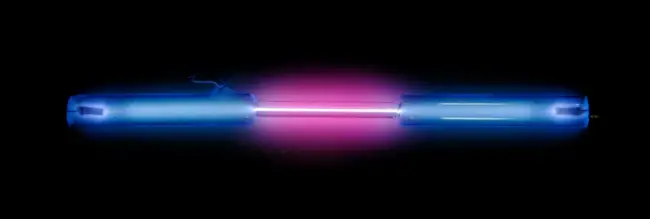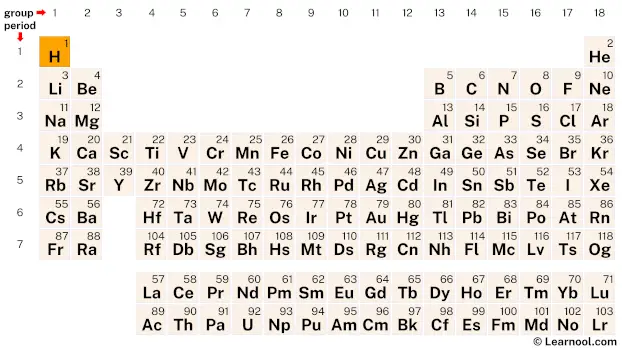
Hydrogen (H) is a chemical element of the periodic table, located in the group 1 and the period 1, and is having the atomic number 1. It is a colorless, odorless, tasteless, highly combustible gas, whose name comes from the Greek word “hydro” and “genes”, which means water forming. It is a reactive nonmetal. It is the lightest element and is the tenth most abundant element on earth.
On periodic table
| group | ⇨ | 1 | 2 | 3 | 4 | 5 | 6 | 7 | 8 | 9 | 10 | 11 | 12 | 13 | 14 | 15 | 16 | 17 | 18 |
| period | ⇩ | ||||||||||||||||||
| 1 | 1 H Hydrogen |
2 He  Helium |
|||||||||||||||||
| 2 | 3 Li  Lithium |
4 Be  Beryllium |
5 B  Boron |
6 C  Carbon |
7 N  Nitrogen |
8 O  Oxygen |
9 F  Fluorine |
10 Ne  Neon |
|||||||||||
| 3 | 11 Na  Sodium |
12 Mg  Magnesium |
13 Al  Aluminium |
14 Si Silicon |
15 P  Phosphorus |
16 S  Sulfur |
17 Cl  Chlorine |
18 Ar  Argon |
|||||||||||
| 4 | 19 K  Potassium |
20 Ca  Calcium |
21 Sc  Scandium |
22 Ti  Titanium |
23 V  Vanadium |
24 Cr  Chromium |
25 Mn  Manganese |
26 Fe  Iron |
27 Co  Cobalt |
28 Ni  Nickel |
29 Cu  Copper |
30 Zn  Zinc |
31 Ga  Gallium |
32 Ge  Germanium |
33 As  Arsenic |
34 Se  Selenium |
35 Br  Bromine |
36 Kr  Krypton |
|
| 5 | 37 Rb  Rubidium |
38 Sr  Strontium |
39 Y  Yttrium |
40 Zr  Zirconium |
41 Nb  Niobium |
42 Mo  Molybdenum |
43 Tc  Technetium |
44 Ru  Ruthenium |
45 Rh  Rhodium |
46 Pd  Palladium |
47 Ag  Silver |
48 Cd  Cadmium |
49 In  Indium |
50 Sn  Tin |
51 Sb  Antimony |
52 Te  Tellurium |
53 I  Iodine |
54 Xe  Xenon |
|
| 6 | 55 Cs  Caesium |
56 Ba  Barium |
72 Hf  Hafnium |
73 Ta  Tantalum |
74 W  Tungsten |
75 Re  Rhenium |
76 Os  Osmium |
77 Ir  Iridium |
78 Pt  Platinum |
79 Au  Gold |
80 Hg  Mercury |
81 Tl  Thallium |
82 Pb  Lead |
83 Bi  Bismuth |
84 Po  Polonium |
85 At  Astatine |
86 Rn  Radon |
||
| 7 | 87 Fr  Francium |
88 Ra  Radium |
104 Rf  Rutherfordium |
105 Db  Dubnium |
106 Sg  Seaborgium |
107 Bh  Bohrium |
108 Hs  Hassium |
109 Mt  Meitnerium |
110 Ds  Darmstadtium |
111 Rg  Roentgenium |
112 Cn  Copernicium |
113 Nh  Nihonium |
114 Fl  Flerovium |
115 Mc  Moscovium |
116 Lv  Livermorium |
117 Ts  Tennessine |
118 Og  Oganesson |
||
| 57 La  Lanthanum |
58 Ce  Cerium |
59 Pr  Praseodymium |
60 Nd  Neodymium |
61 Pm  Promethium |
62 Sm  Samarium |
63 Eu  Europium |
64 Gd  Gadolinium |
65 Tb  Terbium |
66 Dy  Dysprosium |
67 Ho  Holmium |
68 Er  Erbium |
69 Tm  Thulium |
70 Yb  Ytterbium |
71 Lu  Lutetium |
|||||
| 89 Ac  Actinium |
90 Th  Thorium |
91 Pa  Protactinium |
92 U  Uranium |
93 Np  Neptunium |
94 Pu  Plutonium |
95 Am  Americium |
96 Cm  Curium |
97 Bk  Berkelium |
98 Cf  Californium |
99 Es  Einsteinium |
100 Fm  Fermium |
101 Md  Mendelevium |
102 No  Nobelium |
103 Lr  Lawrencium |
|||||
| – s block |
Hydrogen is an s-block element, situated in the first column and the first row of the periodic table. Its atomic number is 1 and its symbol is H.
Element information
 |
|
 |
|
| Origin of name | Greek word “hydro” and “genes” (which means water forming) |
| Symbol | H |
| Atomic number (Z) | 1 |
| Atomic mass | 1.00784 u |
| Block | s-block |
| Group | 1 |
| Period | 1 |
| Classification | Reactive nonmetal |
| Covalent radius | 31±5 pm |
| Van der Waals radius | 120 pm |
| Melting point | -259.16 ℃, -434.49 ℉, 13.99 K |
| Boiling point | -252.879 ℃, -423.182 ℉, 20.271 K |
| Electron configuration | 1s1 |
| Electrons per shell | 1 |
| Learn how to draw: Hydrogen Bohr model | |
| Crystal structure | Hexagonal |
| Phase at r.t | Gas |
| Density near r.t | 0.08988 g/L |
| Main isotopes | Hydrogen-1, Hydrogen-2 |
| Natural occurrence | Primordial |
| Oxidation state | -1, +1 |
| Electronegativity (Pauling scale) | 2.20 |
| Protons Neutrons Electrons |
1 0 1 |
| Learn how to find: Hydrogen protons neutrons electrons | |
| Valence electrons | 1 |
| Learn how to find: Hydrogen valence electrons | |
| CAS number | 12385-13-6 |
| Discovered by | Henry Cavendish in 1766 |
History

The history of hydrogen dates back to the early 16th century when the Swiss physician and alchemist Paracelsus discovered that the gas produced when certain metals react with acids could be ignited, and that the resulting flame was not due to the metal but to a new substance, which he named gas sylvestre.
In the late 1700s, the British scientist Henry Cavendish isolated hydrogen gas in its pure form, and he was the first to recognize it as a distinct element. In 1783, French chemist Antoine Lavoisier also identified hydrogen as a distinct element and named it “hydrogen” from the Greek words “hydro” meaning “water” and “genes” meaning “forming.” Lavoisier and his colleague, Pierre-Simon Laplace, conducted experiments on the combustion of hydrogen and determined that water was produced as a result.
Throughout the 19th and 20th centuries, scientists continued to study and explore the properties and uses of hydrogen. In the early 20th century, the German chemist Fritz Haber developed a process to produce ammonia from hydrogen and nitrogen, which revolutionized the production of fertilizers and helped to increase food production. In the mid-20th century, the development of fuel cells, which generate electricity from the reaction of hydrogen with oxygen, opened up new possibilities for the use of hydrogen as a clean and efficient energy source.
Today, hydrogen is used in a wide range of applications, from fueling rockets and producing fertilizers, to powering fuel cells and serving as a potential energy storage medium for renewable energy sources like solar and wind power. As the world continues to seek more sustainable and environmentally friendly sources of energy, the history and potential of hydrogen as a key element in the energy mix continues to be of great interest to scientists, engineers, and policymakers.
Occurrence and production
Hydrogen is the most abundant element in the universe, accounting for about 75% of its elemental mass. However, on Earth, it is relatively rare in its pure form. It is usually found combined with other elements, such as oxygen in water, carbon in methane, and nitrogen in ammonia. Hydrogen is also present in the Earth’s atmosphere in small quantities, mostly as molecular hydrogen, but also as atomic hydrogen and hydrogen ions.
Hydrogen can be produced from a variety of sources, including natural gas, coal, and water. The most common method of producing hydrogen is through steam methane reforming, which involves reacting natural gas with steam to produce hydrogen and carbon dioxide. Another method is through the gasification of coal, which produces a mixture of hydrogen, carbon monoxide, and other gases. Hydrogen can also be produced through electrolysis of water, using electricity to split water molecules into hydrogen and oxygen. Other methods of producing hydrogen include biomass gasification, which converts organic materials into hydrogen and other gases, and photolysis, which uses sunlight to split water molecules into hydrogen and oxygen.
Properties
Hydrogen has an atomic number of 1 and a standard atomic weight of 1.0078, which makes it the simplest and lightest of all elements.
It has a very low boiling point of -252.879 ℃ and a very low melting point of -259.16 ℃.
Hydrogen is a colorless, odorless, and tasteless gas at room temperature and standard pressure.
It is highly flammable and can ignite at concentrations as low as 4% in air.
Hydrogen is a diatomic molecule, meaning that it exists as H2 in its natural state.
It is a highly reactive element and can form bonds with most other elements, including metals, nonmetals, and metalloids.
Hydrogen gas is less dense than air and is highly buoyant, which makes it useful for filling balloons and airships.
Applications
Hydrogen is used as a fuel in combustion engines, such as in cars and buses, to generate power. It can also be used to generate electricity in fuel cells.
Hydrogen is used in the production of ammonia, which is an important component in fertilizers.
Hydrogen is used in the refining of crude oil, to remove sulfur and other impurities from petroleum products.
Hydrogen is used in the manufacturing of semiconductors and electronics.
Hydrogen is used in the production of methanol, which is a key ingredient in the production of chemicals and plastics.
Hydrogen is used in the production of hydrogen peroxide, which is used as a disinfectant, bleaching agent, and in the manufacture of other chemicals.
Hydrogen is used in welding and cutting processes in the metalworking industry.
Hydrogen is used in the food industry for the hydrogenation of oils and fats, which is used in the production of margarine, for example.
Hydrogen can also be used as a reducing agent in various chemical processes.
Hydrogen is used in scientific research as a tracer gas in various experiments.
Interesting facts
Hydrogen is the most abundant element in the universe, accounting for about 75% of its elemental mass.
Despite being the most abundant element in the universe, hydrogen is relatively rare on Earth in its elemental form.
Hydrogen gas is extremely flammable and can ignite spontaneously in air.
Hydrogen has the highest energy content per unit of weight of any known fuel, making it a potentially valuable source of energy.
Hydrogen has many potential applications, including fuel cells for transportation, power generation, and energy storage.
Hydrogen gas was first produced by the British chemist Henry Cavendish in 1766 by reacting metals with acids.
The name “hydrogen” comes from the Greek words “hydro” meaning water and “genes” meaning forming, as hydrogen was first discovered in the formation of water.
Hydrogen is used in the production of many important chemicals, including ammonia, methanol, and petroleum products.
In its liquid form, hydrogen is one of the coldest substances known, with a boiling point of -252.879 ℃ or -423.182 ℉.
Related
More elements
External links
- https://www.rsc.org/periodic-table/element/1/hydrogen
- https://en.wikipedia.org/wiki/Hydrogen
- https://www.britannica.com/science/hydrogen
- https://pubchem.ncbi.nlm.nih.gov/element/Hydrogen
- https://www.livescience.com/28466-hydrogen.html
- https://www.ducksters.com/science/chemistry/hydrogen.php
- https://chemistrytalk.org/hydrogen-element/
- https://education.jlab.org/itselemental/ele001.html
- https://www.chemicool.com/elements/hydrogen.html
Deep
Learnool.com was founded by Deep Rana, who is a mechanical engineer by profession and a blogger by passion. He has a good conceptual knowledge on different educational topics and he provides the same on this website. He loves to learn something new everyday and believes that the best utilization of free time is developing a new skill.
